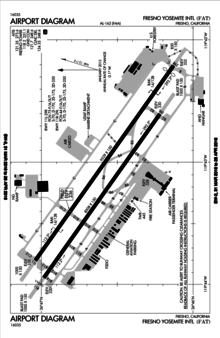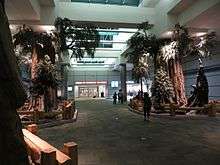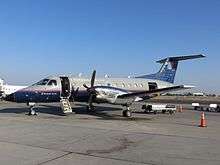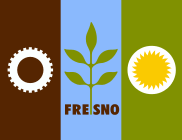Fresno Yosemite International Airport
| Fresno Yosemite International Airport | |||||||||||||||
|---|---|---|---|---|---|---|---|---|---|---|---|---|---|---|---|
|
| |||||||||||||||
 USGS aerial image, 1998 | |||||||||||||||
| IATA: FAT – ICAO: KFAT – FAA LID: FAT | |||||||||||||||
| Summary | |||||||||||||||
| Airport type | Public / Military | ||||||||||||||
| Owner | City of Fresno | ||||||||||||||
| Operator | City of Fresno Airports Division | ||||||||||||||
| Serves | Fresno, California | ||||||||||||||
| Elevation AMSL | 336 ft / 102 m | ||||||||||||||
| Coordinates | 36°46′36″N 119°43′08″W / 36.77667°N 119.71889°WCoordinates: 36°46′36″N 119°43′08″W / 36.77667°N 119.71889°W | ||||||||||||||
| Website |
www | ||||||||||||||
| Maps | |||||||||||||||
 Runway Diagram | |||||||||||||||
 FAT  FAT  FAT | |||||||||||||||
| Runways | |||||||||||||||
| |||||||||||||||
| Statistics (2015) | |||||||||||||||
| |||||||||||||||
Fresno Yosemite International Airport (IATA: FAT, ICAO: KFAT, FAA LID: FAT), formerly Fresno Air Terminal, is a joint civil-military public airport in eastern Fresno, in Fresno County, California. Located approximately 64 miles south of Yosemite National Park on California State Route 41, it is the closest airfield to the Park with scheduled passenger airline jet service and is also located near two freeways being California State Route 168 and California State Route 180. The airport covers 2,150 acres (870 ha) and has two runways and one helipad. It is the air transport center for the San Joaquin Valley, with flights to several airline hubs in the western United States. International flights to Mexico are available through Aeroméxico and Volaris. It is also home to Fresno Air National Guard Base and the 144th Fighter Wing (144 FW) of the California Air National Guard.
History
The airfield opened in June 1942. During World War II the airfield was known as Hammer Field and was used by the United States Army Air Forces' Fourth Air Force. Hammer Field was a training base and had three sub-bases and two gunnery ranges.
The airfield was renamed Fresno Air Terminal, and retained a military cantonment area for an Army Air Forces unit of the National Guard that became a unit of the Air National Guard when the U.S. Air Force was established as a separate service in 1947.
Today the California Air National Guard 144th Fighter Wing (144 FW) occupies two separate parcels of land at the airport—the main base area and the Munitions Storage Area. These areas of the airport are known as the Fresno Air National Guard Base.[3] This military unit currently operates F-15 "Eagle" jet fighters, and previously operated F-16C "Fighting Falcon" and F-4D "Phantom" jet interceptor aircraft. [4][5]
Trans World Airlines (TWA) and United Airlines flights to San Francisco/Oakland and Los Angeles moved from Chandler Field (now Fresno Chandler Executive Airport) to Fresno Air Terminal in 1947; TWA dropped Fresno in 1963.
In 1988 the FAA designated the airport an "International Point of Entry", allowing international flights.
In 1996 the airport's name was changed to attract out-of-state and international visitors to Yosemite National Park. The airport applied for a new FAA identifier code when its name was changed, however the FAA will only assign a new airport identifier code when an airport physically moves to another location, such as in 1995 when Denver Airport moved from Stapleton (DEN to DVX).[6] Since its opening, the airport has gone through multiple renovations and expansions. In 2002, a new two-level concourse building designed by DMJM Aviation was completed and in 2006 construction of a new Federal Inspection Facility (FIS) was completed.[7]
Airline service
Fresno has been the headquarters for at least three airlines. In the mid 1990s Air 21 flew Fokker F28 Fellowship jets to several destinations including nonstop to Las Vegas, Los Angeles, Salt Lake City and San Francisco, and direct to Colorado Springs.[8] Allegiant Air also called Fresno home but then moved its headquarters to Las Vegas. In 2000, Allegiant was operating McDonnell Douglas DC-9 jet service nonstop to Las Vegas and Long Beach.[9] Far West Airlines was also based in Fresno and in 1984 was operating a small intrastate hub at the airport with nonstop flights to the California destinations of Burbank, Los Angeles, Modesto, Oakland, Orange County, Sacramento and San Jose as well as one stop direct flights to Ontario via Burbank, all flown with 60-passenger seat NAMC YS-11 turboprop aircraft.[10]
United Airlines was a major player at the airport for many years, operating Boeing 727-100, Boeing 727-200, Boeing 737-200, Boeing 737-300 and Douglas DC-8 jets. United even flew stretched Douglas Super DC-8 series 61 (DC-8-61) flights to Denver, San Francisco and Los Angeles. With over 200 seats these DC-8-61s were the largest airliners ever scheduled into Fresno. In 1979, the airline was operating up to eleven mainline jet flights a day from Fresno with nonstop Boeing 727-200 service to Chicago and Denver as well as nonstop Boeing 727-200 and 737-200 service to Los Angeles and San Francisco.[11] United Airlines remains the longest continuously-operating carrier out of Fresno Yosemite International Airport with daily nonstop flights to Denver, Los Angeles and San Francisco although all United service is currently flown by regional airline partner SkyWest with Canadair CRJ-200, CRJ-700 and Embraer E-175 regional jets operating as United Express via a code sharing agreement.[12]
Other airlines that operated jet service into Fresno from the mid 1960s through the 1990s included:
- Pacific Air Lines with Boeing 727-100s
- Hughes Airwest (formerly Air West) with Douglas DC-9-10s and McDonnell Douglas DC-9-30s
- Republic Airlines (1979-1986) with Boeing 727-200s, Douglas DC-9-10s and McDonnell Douglas DC-9-30s
- Pacific Southwest Airlines (PSA) with Boeing 727-100s, 727-200s, 737-200s, British Aerospace BAe 146-200s and McDonnell Douglas MD80s
- Western Airlines with Boeing 727-200s, 737-200s and 737-300s
- Delta Air Lines with Boeing 727-200s and 737-300s
- The original Frontier Airlines (1950-1986) with Boeing 737-200s
- Continental Airlines with Boeing 737-200s and 737-300s
- AirCal (formerly Air California) with Boeing 737-200s
- Morris Air with Boeing 737-300s
- Pacific Express with Boeing 737-200s and British Aircraft Corporation BAC One-Elevens
- Jet America Airlines with McDonnell Douglas MD80s
- Horizon Air with Fokker F28 Fellowships
- America West Express with Canadair CRJ-200s and Fokker F70s
Pacific Air Lines was the first airline to schedule jets into Fresno when it initiated Boeing 727-100 service nonstop to both Los Angeles and San Francisco in 1966.
In the 1990s there was a shift to smaller regional jet and turboprop aircraft; however, mainline jets still serve Fresno. Mainline jet aircraft currently serving Fresno include Boeing 737-800 service nonstop to Dallas/Fort Worth operated by American Airlines. Allegiant Air flies McDonnell Douglas MD80s nonstop to Las Vegas and Phoenix/Mesa and was also operating Boeing 757-200 nonstops to Honolulu before ceasing service to Hawaii from the airport. Aeroméxico flies Boeing 737s while Volaris operates Airbus A319s with both airlines flying nonstop to Guadalajara, Mexico. Delta Air Lines had announced new flights to Fresno from Atlanta; however, this service was then cancelled before it began. The current version of Frontier Airlines was flying nonstop Airbus A319 service to Denver three days a week but has since abandoned this service.
Direct international service from Fresno ended when Mexicana ceased operations in August 2010 to Guadalajara International Airport, Mexico. However, international flights returned when Volaris and Aeroméxico restored service between Fresno and Guadalajara in April 2011.[13][14]
Fresno is the largest city in the continental United States not served by Southwest Airlines. Morris Air operated Boeing 737-300s into the airport but ceased all service after the airline was acquired by Southwest Airlines.[15]
Facilities and aircraft


Fresno Yosemite International Airport covers 1,728 acres (699 ha) at an elevation of 336 ft (102 m) above mean sea level, with two paved asphalt runways: 11L/29R (primary) and 11R/29L (secondary). Runway 11L/29R is 9,539 by 150 ft (2,907 by 46 m), and runway 11R/29L is 8,008 by 150 ft (2,441 by 46 m).[1]
Completed in 2010, CSHQA designed the $10 million Terminal Building Expansion and Remodel – The portion included a multi-phased rehabilitation of the ticketing lobby, central lobby (including the unique sequoia forest exhibit), the rental car counter areas, and the expansion of baggage claim. The enhanced ticket lobby incorporates an open floor plan with high ceiling interiors; houses all airline ticket counters in the same space; provides large open common use baggage screening and processing rooms, and introduces a more high tech image through the use of LCD screen displays and other material and lighting elements. The central lobby area includes the "sense of place" Sequoia Treescape project. The expanded baggage claim area accommodates higher capacity equipment, and provides more circulation space for travelers.[16]
A US$30 million construction project was completed in October 2012 to widen, lengthen and strengthen secondary runway 11R/29L.[17]
For the year ending September 30, 2009 the airport had 143,945 aircraft operations, an average of 394 per day: 65% general aviation, 18% air taxi, 10% scheduled commercial, and 8% military. At that time there were 195 aircraft based at the airport: 47% single-engine, 23% multi-engine, 6% jet, 11% helicopter and 13% military.[1]
Passenger totals
In 2015, Fresno Yosemite International Airport totaled 1,408,922 passengers, marking a notable 21% increase in passengers since 2009.[18]
In 2014, 1,442,026 passengers flew through Fresno Yosemite International Airport, breaking the previous record from 2013.[19]
In 2013, 1,401,582 passengers arrived and departed through Fresno Yosemite International Airport, exceeding the previous record of 1,318,493 passengers in 2007 by 6.3%. This increase is contributed to the introduction of larger jet aircraft and new destinations. Flights to and from Fresno Yosemite International Airport averaged a load factor of 82% in 2013.[20]
In 2011 over 1.2 million passengers traveled through Fresno Yosemite International Airport, a 6.4% increase from 2010.
Fresno completed 2006 with 1.281 million passengers traveling through Fresno Yosemite International Airport, an increase of 7.54% over 2005.
Fresno completed 2007 with 1.382 million passengers traveling through Fresno Yosemite International Airport, an increase of 3.13% over 2006.
Airlines and destinations

Passenger
| Airlines | Destinations |
|---|---|
| Aeroméxico | Guadalajara |
| Alaska Airlines operated by Horizon Air | Seasonal: Portland (OR), San Diego |
| Alaska Airlines operated by SkyWest Airlines | Portland (OR), San Diego, Seattle/Tacoma |
| Allegiant Air | Las Vegas, Phoenix/Mesa |
| American Airlines | Dallas/Fort Worth Seasonal: Phoenix–Sky Harbor |
| American Eagle | Los Angeles, Phoenix–Sky Harbor |
| Delta Connection | Salt Lake City |
| United Express | Denver, Los Angeles, San Francisco |
| Volaris | Guadalajara |
Cargo
| Airlines | Destinations |
|---|---|
| Ameriflight | Oakland, Santa Maria, Visalia |
| FedEx Express | Reno/Tahoe Seasonal: Los Angeles[21] |
| UPS Airlines | Ontario Seasonal: Louisville[22] |
Statistics
Top destinations
| Rank | City | Passengers | Carriers |
|---|---|---|---|
| 1 | Phoenix, Arizona | 105,000 | American/US Airways |
| 2 | Los Angeles, California | 87,000 | American, United Express |
| 3 | Dallas/Fort Worth, Texas | 84,000 | American |
| 4 | Denver, Colorado | 63,000 | Frontier, United Express |
| 5 | San Francisco, California | 55,000 | United Express |
| 6 | Las Vegas, Nevada | 55,000 | Allegiant, United Express |
| 7 | Seattle/Tacoma, Washington | 53,000 | Alaska |
| 8 | Salt Lake City, Utah | 53,000 | Delta Connection |
| 9 | San Diego, California | 45,000 | Alaska |
| 10 | Portland, Oregon | 29,000 | Alaska |
Firsts
- FAT was the first airport in the country to implement an anti-terrorist facial recognition system, shortly after the September 11, 2001, attacks.
- The first airport in the Nation to install a web-based, wireless system (PASSUR Flight Information Display) to list active flight arrivals and departures.
Military
- The 144th Fighter Wing of the California Air National Guard is based out of the Fresno Yosemite International Airport.[24]
- The California Army National Guard maintains an Aviation Classification Repair Activity Depot (AVCRAD) at the airport. The mission of this unit is to perform high level maintenance and repair on Army aircraft. Its jurisdiction covers a 15-state region in the Western United States.
- Both the U.S. Forest Service and the California Department of Forestry operate an Air Attack Base at the airport for fighting forest fires with aerial tankers.
Solar power
Fresno Yosemite International features a 2.4 megawatt solar system, completed in March 2008. The airport purchases solar-generated electricity from the system, which is owned, operated, and maintained by Solar Power Partners and its investors. Solar Power Partners contracted WorldWater & Solar Technologies Corp to construct the system. The solar system was financed through a solar power purchase agreement, which required no capital outlay from the airport. At the time of commissioning, the system was the largest airport solar system in the nation.
Accidents and incidents
On September 13, 2015, an MD-87 of Aero Air LLC had an engine failure after taking off from Fresno Yosemite International Airport. Pieces of the engine struck a car, damaging it. The aircraft was able to return to the airport safely.[25]
On December 14, 1994, a private jet on a military training mission, attempting to land at Fresno, crashed on a Fresno street and careened into a crowded apartment complex. The plane, piloted by two civilians and belonging to a Georgia-based company, Phoenix Air, had finished chasing an F-16 fighter during a war game shortly before noon. The plane was returning to the Fresno airport when the crew radioed the tower about engine trouble. The aircraft attempted to land on a city street, however struck several power poles and then crashed into an apartment complex on Olive Ave. Both crew members, and at least one person on the ground were killed, however an exact number of ground fatalities are still currently unknown.[26]
References
- 1 2 3 FAA Airport Master Record for FAT (Form 5010 PDF). Federal Aviation Administration. Effective March 10, 2011.
- ↑ "Corporate Information". The City of Fresno. January 2016. Retrieved July 23, 2016.
- ↑ "Inside the 144th FW". 144th Fighter Wing, California Air National Guard. 2010. Retrieved December 23, 2010.
- ↑ "All sizes - Fresno 1955_0001 - Flickr - Photo Sharing!".
- ↑ "Hammer Field Runway Fresno late 1950's--2". Flickr - Photo Sharing!.
- ↑ Fresno Yosemite International (2010). "Frequently Asked Questions". City of Fresno. Archived from the original on March 20, 2011. Retrieved December 23, 2010.
- ↑ "Decade in Review: Top 10 in Fresno Architecture". archop. December 31, 2009. Retrieved May 1, 2013.
- ↑ "Air 21 Mar. 4, 1996 system timetable and route map". Departedflights.com.
- ↑ http://www.departedflights.com, June 1, 2000 Allegiant Air route map
- ↑ http://www.departedflights.com, Sept. 17, 1984 route map
- ↑ http://www.departedflights.com, Nov. 15, 1979 Official Airline Guide (OAG), Fresno schedules
- ↑ http://www.unitedairlines.com, system timetable
- ↑ "Volaris to Start Flying from FYI to Mexico". WorldNow / KMPH. March 1, 2011. Retrieved March 4, 2011.
- ↑ Sheehan, Tim (March 10, 2011). "Aeroméxico to start Fresno flights April 4". The Fresno Bee. Retrieved March 10, 2011.
- ↑ Sheryl (June 18, 2011). "Test Your Knowledge of Southwest Airlines on Their 40th Birthday Which is Today". Flyertalk. Retrieved May 20, 2013.
- ↑ Roebbelen Contracting
- ↑ "Airports $35 Million Improvements Award Provide Economic Boost to Valley" (Press release). Fresno Yosemite International Airport. September 29, 2011. Retrieved June 29, 2012.
- ↑ http://flyfresno.com/press/read/article/51
- ↑ "Security Check Required". Facebook.
- ↑ https://www.flyfresno.com/documents/Jan%202014%20Record%20Breaking%20Passengers.pdf
- ↑ http://www2.alpa.org/fdx/jumpseat/
- ↑ http://inside.ipapilot.org/tools/jumpseats/index.php
- ↑ "RITA | BTS | Transtats: Fresno, CA: Fresno Yosemite International (FAT)". Bureau of Transportation Statistics. Retrieved November 30, 2016.
- ↑ "Fresno Air National Guard Base". Global Security. 2005. Retrieved March 5, 2011.
- ↑ "Report that pieces of metal fell from Erickson MD-87 air tanker over Fresno, California". Fire Aviation.
- ↑ "At Least 3 Killed as Plane Crashes on Fresno Street : Accident: Learjet has engine trouble while returning to airport. It slams into apartment complex, creating grim scene of destruction.". latimes.
External links
![]() Media related to Fresno Yosemite International Airport at Wikimedia Commons
Media related to Fresno Yosemite International Airport at Wikimedia Commons
- Fresno Yosemite International Airport, official web site
- FAA Airport Diagram (PDF), effective December 8, 2016
- FAA Terminal Procedures for FAT, effective December 8, 2016
- Resources for this airport:
- AirNav airport information for KFAT
- ASN accident history for FAT
- FlightAware airport information and live flight tracker
- NOAA/NWS latest weather observations
- SkyVector aeronautical chart for KFAT
- FAA current FAT delay information

